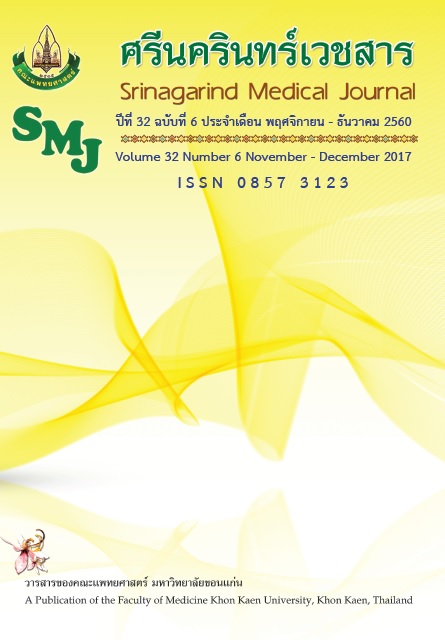Comparison Study of Computed Tomographic Characteristics between Arterial Phase and Portovenous Phase of Cholangiocarcioma by Multidetector CT
Keywords:
cholangiocarcinoma; arterial phase; portovenous phase; multidetector; CT; มะเร็งท่อน้ำดี; ช่วงหลอดเลือดแดง; ช่วงหลอดเลือดดำพอร์ทัล; เครื่องเอกซเรย์คอมพิวเตอร์ชนิดมัลติดีเทคเตอร์Abstract
Background and Objective : The population of Northeast Thailand is one of the highest rates of Cholangiocarcinoma. Diagnosis cholangiocarcinoma is importance. Multiphase CT for diagnosis cholangiocarcinoma is used precontrast, arterial phase, portovenous phase and delayed phase. This study aimed to compare computed tomographic characteristics between arterial phase and portovenous phase assessment cholangiocarcinoma
Methods : A retrospective descriptive study was conducted on cholangiocarcinoma patients diagnosed from January 2016 - December 2016 in Yasothon Hospital. All patients have sign symptom and computed tomographic characteristics of cholangiocarcinoma with at least one choice following by 1. Abnormal CEA or CA19-9 2. Pathological report 3. MRI assessment cholangiocarcinoma. The Chi-Square test and Fisher’s Exact test were used for statistical analysis.
Results : Of 105 patients , the author was able to detect tumor mass 97 patients by arterial phase less than102 patients by portovenous phase. Tumor enhancement most of them were hypodense 84 patients by arterial phase, 87 patients by portovenous phase. Adenopathy 72 patients by portovenous phase more than 66 patients by arterial phase. Bile duct dilatation were able detect 101 patients by arterial phase equal to portovenous phase. Arterial phase and portovenous phase could not detect arterial involvement. Hepatic artery could detect105 patients by arterial phase, 3 patients by portovenous phase. These findings were not statistically significant (p value >0.05) by Chi-Square test. But venous involvement (5 patients by arterial phase, 38 patients by portovenous), portal vein and hepatic vein (3 patients by arterial phase, 105 patients by portovenous phase) were seen by portovenous phase more than arterial phase (p value <0.05). It was statistically significant by Fisher’s Exact test.
Conclusion : Arterial phase and portovenous phase were detected tumor mass, tumor enhancement, adenopathy, bile duct dilatation, hepatic artery, artery involvement no statistical significant but venous involvement portal vein and hepatic vein by portovenous phase were seen more than arterial phase




